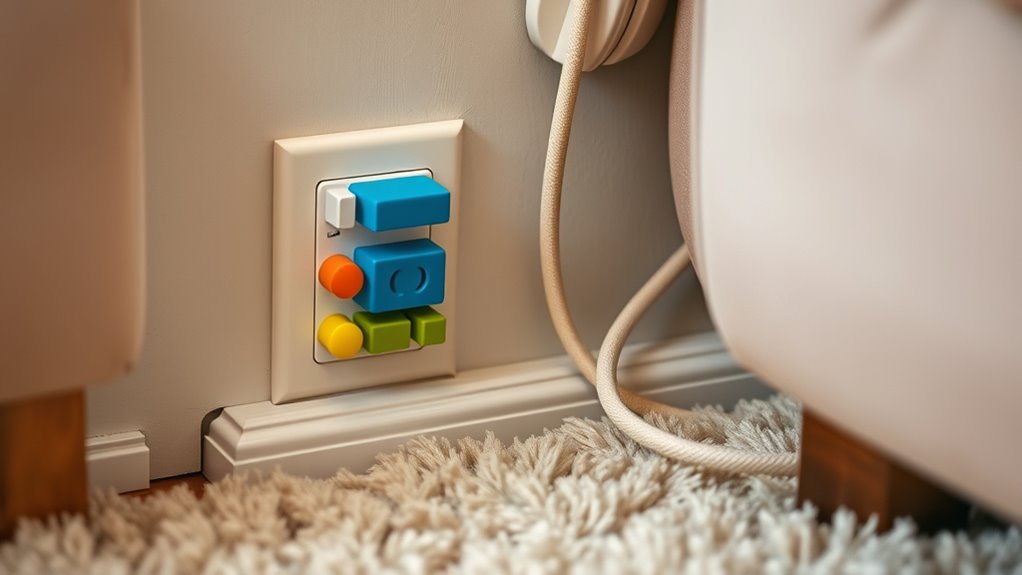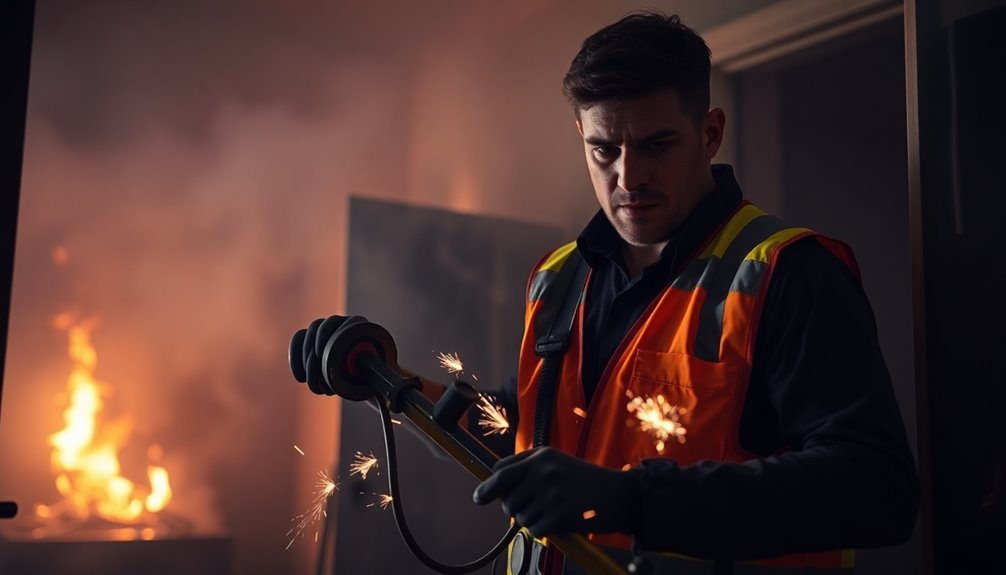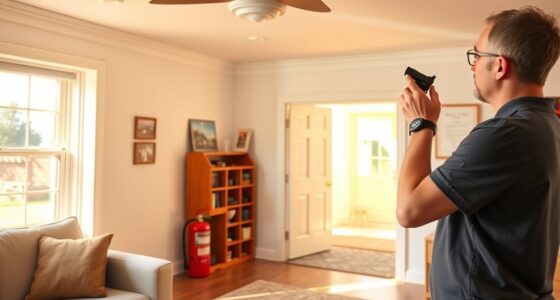To childproof electrical outlets and cords, start by installing outlet covers or tamper-resistant outlets to prevent children from inserting objects. Use cord organizers like covers, clips, or ties to keep cords out of reach and prevent tripping hazards. Regularly inspect safety devices and cords for damage, and teach children about electrical safety to help them understand potential dangers. Keep your home organized and secure; if you explore further, you’ll discover more tips to create a safer environment.
Key Takeaways
- Install outlet covers or safety plugs to prevent children from inserting objects into outlets.
- Use tamper-resistant outlets that lock when no plug is inserted.
- Secure and organize cords with covers, clips, and ties to minimize tripping and pulling hazards.
- Regularly inspect outlets and cords for damage and replace any damaged components immediately.
- Educate children with visual aids and safety lessons to reinforce electrical safety habits.
Understanding the Risks of Unprotected Outlets and Cords
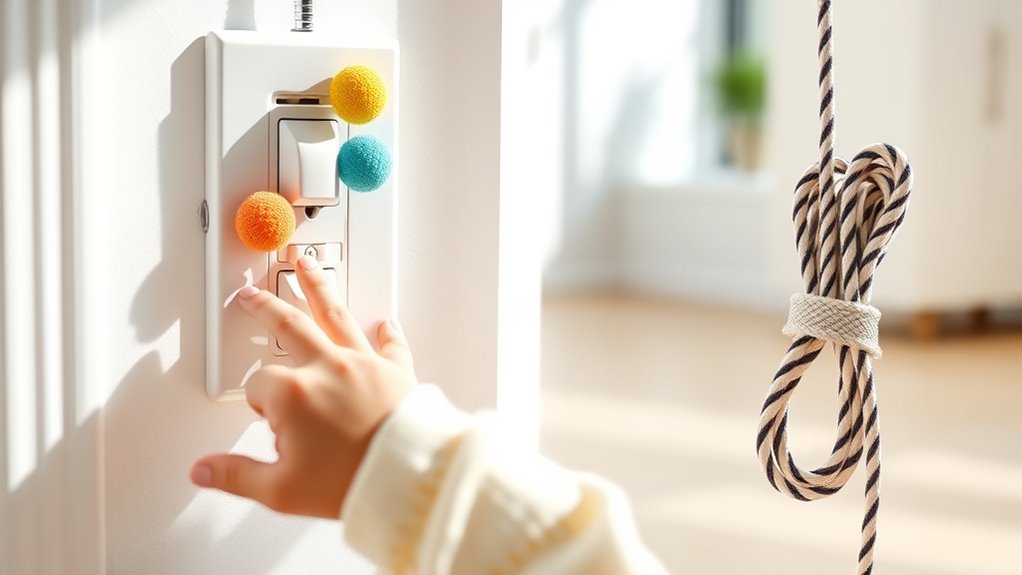
Unprotected electrical outlets and cords pose serious safety hazards for children. Curious kids may insert fingers, toys, or other objects into outlets, risking electric shock or burns. Loose or exposed cords can also be pulled, causing devices to fall or sparks to ignite nearby objects. Small children are naturally enthusiastic explorers, and without safeguards, they can easily access dangerous electrical components. Even a brief contact with live outlets can result in severe injuries. Additionally, tangled cords create tripping hazards, increasing the risk of falls. Recognizing these dangers is essential for keeping your child safe. By understanding how unprotected outlets and cords can harm your child, you’ll be motivated to take preventive measures to minimize these risks. Proper safety precautions can further reduce the likelihood of accidents, providing peace of mind. Your vigilance can prevent accidents before they happen.
Installing Safety Devices for Electrical Outlets

Installing safety devices on electrical outlets is one of the most effective ways to protect your child from electric shocks and injuries. Outlet covers or safety plugs prevent little fingers from inserting objects into sockets. Simply insert the covers into unused outlets, making certain they stay securely in place. For added security, consider tamper-resistant outlets, which automatically lock when no plug is inserted and only release when a proper plug is inserted. These outlets are a permanent solution and require no additional accessories. When choosing safety devices, opt for products that are easy to install and remove for adults but difficult for children to manipulate. Regularly check the covers or tamper-resistant outlets to make sure they remain intact and secure. Understanding essential oils can help you select the best products for your needs. This simple step considerably reduces the risk of accidental shocks.
Choosing the Right Cord Management Solutions
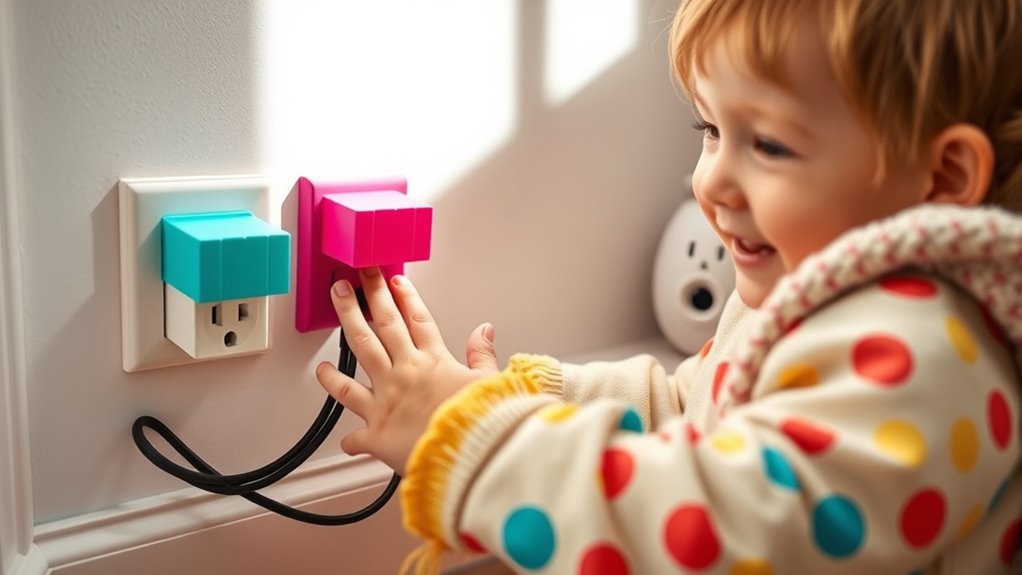
Ever wonder how to keep your child’s curious hands away from dangling cords and cluttered outlets? The key is choosing the right cord management solutions. Start with cord covers or conduits to hide and protect cords running along walls or floors. These keep cords out of reach and prevent tripping hazards. Cable clips and ties help organize cords, reducing clutter and making cleaning easier. If you have multiple devices, consider a power strip with a built-in safety cover or a surge protector with individual switches to easily turn off unused devices. For added safety, opt for cordless options whenever possible. Selecting the right solutions depends on your space, the number of devices, and your child’s activity level. Well-chosen cord management keeps your home safer and more organized, especially considering how noise levels of modern heat pumps are designed to be quiet for comfort.
Tips for Organizing and Securing Cords
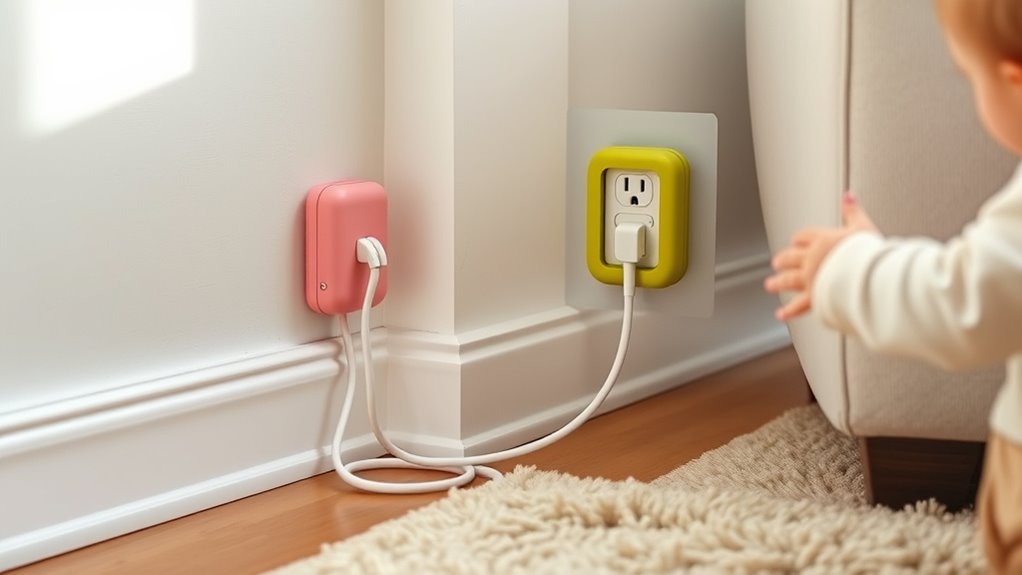
To keep your cords organized and secure, start by grouping similar cables together using cable ties or Velcro straps. This helps prevent tangling and makes it easier to identify specific cords. Once grouped, route them along walls or furniture edges, securing them with adhesive clips or cord covers. For added safety, keep cords out of children’s reach and avoid running them across walkways. To visualize, consider this setup:
| Cables grouped together | Secured along walls or furniture |
|---|---|
| Tied with Velcro straps | Held with adhesive clips |
| Out of children’s reach | Tucked away in cord covers |
| Avoiding crossing walkways | Neatly organized and accessible |
This approach minimizes tripping hazards and keeps cords tidy, reducing the risk of accidental pulling or damage. Incorporating cord management techniques can further enhance safety and organization.
Regular Maintenance and Safety Checks
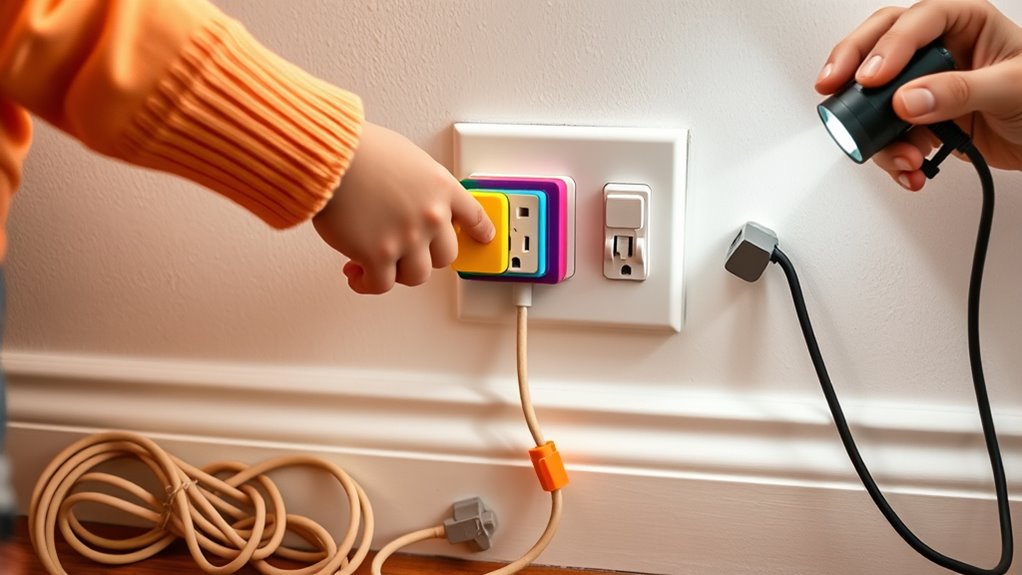
You should schedule regular inspections to guarantee your outlets stay safe. During these checks, look for signs of wear or damage, such as cracks or loose parts. If you find any damaged components, replace them immediately to keep your home childproof and secure. Remember, inspirational quotes about fatherhood can serve as a reminder to protect your loved ones and prioritize their safety.
Schedule Routine Inspections
Regular maintenance is essential to guarantee electrical outlets remain safe for children. Scheduling routine inspections helps catch potential hazards early, ensuring your home stays secure. During these checks, you should:
- Confirm outlet covers are securely in place
- Look for loose or damaged outlet plates
- Ensure no debris or dust is accumulated around outlets
- Verify cords are properly managed and out of reach
- Test GFCI outlets to ensure they trip correctly
- Consider the role of sound vibrations and their influence on cellular health when evaluating overall home safety measures
Check for Wear and Damage
Since wear and damage can compromise outlet safety, it’s important to regularly examine your electrical outlets for signs of deterioration. Look for cracks, chipping, or discoloration around the outlet face, which may indicate deterioration. Check the outlet cover for any looseness or warping. Feel for loose or wobbly outlets that might cause sparks or shorts when plugged in. Also, inspect the socket holes for debris or corrosion, as these can interfere with proper contact. If you notice any signs of damage, avoid using that outlet until it’s properly repaired. Regular visual checks help you catch issues early, reducing the risk of electrical hazards. Staying vigilant ensures your outlets remain safe for everyone in your home. Additionally, understanding emergency preparedness essentials can help you respond effectively if electrical issues lead to emergencies.
Replace Damaged Components
When you notice signs of wear or damage on your outlets, replacing the damaged components promptly can prevent potential hazards. Damaged parts, like cracked covers or loose wiring, increase the risk of electrical shocks or fires. Regularly inspect your outlets and replace any compromised parts immediately. Incorporating growing awareness of electrical safety can help you prioritize regular maintenance and safety checks. To do this effectively, you should: – Turn off the power at the breaker before starting – Use insulated tools for safety – Remove the outlet cover carefully – Check for loose or frayed wires – Replace cracked or broken outlet components Always guarantee replacements match your outlet model. If you’re unsure or uncomfortable, consult a professional electrician. Keeping your outlets in good condition minimizes hazards and helps maintain a safe environment for children.
Educating Children About Electrical Safety
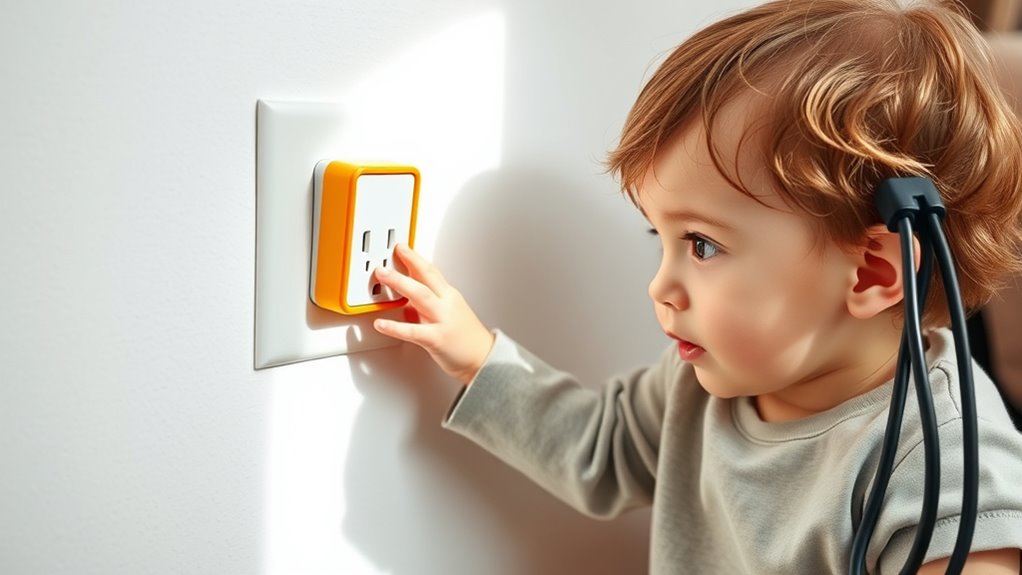
Teaching your children safety rules helps them understand the dangers of electrical outlets. Using visual aids, like pictures or videos, makes these lessons clearer and more memorable. By actively involving them, you can instill safe habits early on. Introducing concepts about electric power generation, such as how bikes can generate electricity, can also help children grasp the importance of safe energy use.
Teaching Safety Rules
Educating children about electrical safety is essential for preventing accidents and ensuring they understand the importance of safe behaviors around outlets. Teaching clear safety rules helps children develop good habits early on. Make sure your child knows:
- Never insert objects into outlets
- Always ask an adult before using electrical devices
- Keep cords out of reach and untangled
- Stay away from damaged cords or outlets
- Recognize warning signs of electrical hazards
- Understanding ethical hacking concepts can also help in recognizing potential security risks related to electrical devices and systems.
Using Visual Aids
Using visual aids can make electrical safety lessons more effective by capturing children’s attention and helping them remember key concepts. Bright pictures, diagrams, or simple videos show children what dangers look like and how to stay safe. For example, you might use colorful posters of outlets with and without covers or short animations demonstrating what happens if they insert objects into outlets. Visuals make abstract ideas tangible, making it easier for kids to grasp safety rules. You can also create storyboards or comic strips that depict safe behaviors, making learning fun and engaging. When children see visual examples, they retain safety messages longer and are more likely to follow them. Incorporating visual aids into your lessons boosts understanding and encourages kids to practice safe habits consistently.
Frequently Asked Questions
Are There Childproof Outlet Covers That Also Prevent Dust Accumulation?
You’re wondering if there are outlet covers that prevent dust buildup too. Yes, there are. Many childproof outlet covers are designed with a smooth, sealed surface that keeps dust and debris from collecting inside. Some models even feature airtight seals or snap-on covers that close tightly when not in use. These options help keep your outlets clean and safe, giving you peace of mind while protecting your little one.
How Can I Discreetly Hide Electrical Cords to Maintain Home Aesthetics?
Imagine gently guiding your cords behind a flowing tapestry or within sleek concealing channels to preserve your home’s elegance. You can use cord covers that blend seamlessly with your decor, or run cords along baseboards painted to match. Cord clips and furniture placements can also help hide and organize wires discreetly. With a little creativity, you keep your space beautiful while ensuring safety and accessibility.
Do Cord Management Products Interfere With Fire Safety Standards?
You wonder if cord management products interfere with fire safety standards. Generally, high-quality products are designed to meet safety regulations and won’t increase fire risk. However, if you use cheap or faulty materials, they could pose hazards like overheating or block ventilation. Always choose products certified by safety organizations, keep cords neat and accessible, and avoid overloading outlets. This way, you can manage cords safely without compromising fire safety.
What Are the Best Practices for Childproofing Outlets Outdoors?
Childproofing outdoor outlets is like shielding a fragile bloom from harsh weather. You should install weatherproof covers that latch securely, ensuring little hands can’t access the sockets. Always turn off power before installing or inspecting covers, and use outdoor-rated extension cords when needed. Keep cords neatly organized, away from water and high-traffic areas. Regularly check covers and cords for wear, so your kids stay safe while enjoying the outdoors.
How Often Should I Replace Worn or Damaged Outlet Safety Covers?
You should check your outlet safety covers regularly, ideally once a month, to see if they’re worn or damaged. If you notice cracks, fading, or looseness, it’s time to replace them immediately. Damaged covers can’t properly protect your child from electrical shocks. Keep a supply of new covers handy so you can swap them out quickly whenever needed. Regular inspections help guarantee your child’s safety around electrical outlets.
Conclusion
By childproofing your outlets and cords, you become the steady lighthouse guiding your little sailor safely through treacherous waters. With vigilant safety devices and organized cords, you create a fortress of protection around your home’s electrical landscape. Remember, regular checks and gentle education turn your space into a sanctuary where curiosity is met with safety, allowing your child to explore freely without shadowed fears. Your attentive care transforms potential hazards into harmless ripples on calm waters.
